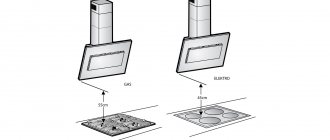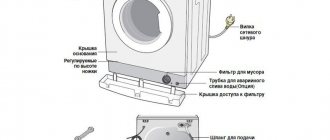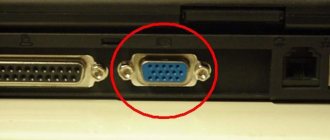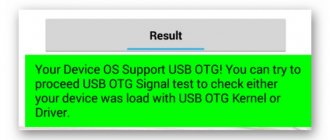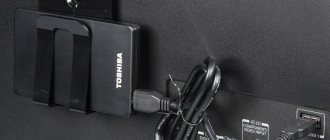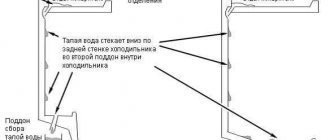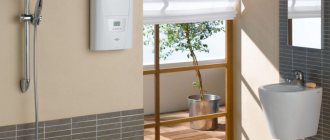An electric stove is an excellent choice for a modern kitchen. If installed and used correctly, the device will serve well for many years. Of course, you can invite a qualified technician to connect the electric stove, but if you wish, you can do everything yourself and save a lot!
Connecting an electric stove yourself
Familiarize yourself with the basic requirements for connecting modern electric stoves, existing circuits, as well as guides for direct installation of the device and its grounding.
Connecting an electric stove yourself
Wiring Requirements
Apartment shield
Introductory machine
Important! Before you begin any manipulations with wires and electrical appliances, turn off the electricity supply to your house or apartment.
Modern models of electric stoves are usually sold without a cord included. There is a reasonable explanation for this: safety regulations require that such devices be connected using high-quality terminal blocks, i.e. according to the so-called rosette-free method. With this connection option, you can increase the length of the power cord, and instead of a machine for more powerful models, you can install a fuse-link.
For connection, you need to use a cable with a cross-section of 4 mm2, if its length does not exceed 12 m. In the case of using a longer wire, the minimum permissible cross-section increases to 6 mm2. In this case, it is imperative to install a separate machine specifically for the stove.
Selection of cable cross-section
Connection via a socket is also acceptable. It is only necessary that the device be designed for a current of 32 A. Electric stoves consume quite a lot of energy, so plugging them into simple household sockets is prohibited.
Socket options for electric stoves
Thus, the requirements for connecting an electric stove can be combined into a short but very important list, which includes the following provisions:
- to connect the device, a three-core copper cable with a cross-section of 4 mm2 or 6 mm2 is used, depending on the length of the cord;
- a separate circuit breaker for the stove is installed in the electrical panel;
- installation of a residual current device is in progress;
- The stove is grounded using an accessible method. Possible grounding options will be discussed at the end of the manual.
Prices for popular electric cookers
Electric cookers
Connection diagrams for electric stoves
Before proceeding with the actual installation of the device, study the existing device connection diagrams.
Single-phase connection
The most common option. Most often found in apartments of multi-storey buildings.
With a single-phase connection, the connection block will look like this (see diagram).
Single-phase connection
Terminals 1-2-3, as well as 4-5, are connected by copper jumpers with a cross-section of 6 mm2. If you bought a modern stove, the necessary jumpers will be included in the kit.
The phase conductor (can be gray, brown or black) is connected to terminal number 1, 2 or 3.
The neutral wire (usually blue) is connected to the 4th or 5th terminal. The ground wire (yellow-green in the diagram) is connected to the 6th terminal.
The terminal bolts must be tightened until they stop. If the connection is poor, the terminals may burn, resulting in a fire.
In the case of using a socket connection, we feed the phase conductor in the plug and socket to terminal L, the neutral conductor goes to the terminal marked N, and the grounding wire is connected to the corresponding terminal (marked with a grounding pattern, the letters PE, or the word earth).
Two-phase connection
Two-phase circuit
Rarely, but still there is a two-phase connection. For example, phases A and C may be present, but phase B will not be present.
With this connection, terminals 1 and 2 need to be connected with a jumper and phase A must be connected through it. Phase C goes to the 3rd terminal. The further connection procedure remains similar to the previous methods.
Three-phase connection
Three-phase circuit
Three-phase power supply is most often encountered by owners of private houses. The supply wire in such a situation will consist of 4 or 5 cores. In this case, the voltage between zero and phases will be 220 V, and between the phases themselves - 380 V.
In such conditions, the electric stove will be connected according to the appropriate circuit. Phases A, B and C will go to the corresponding terminals 1, 2 and 3.
The connection of terminals 4, 5 and 6 is similar to a single-phase connection.
Single-phase network 220 V
This case applies mainly to apartments in which the owner decided that during renovations or just because it is worth installing an induction hob instead of a classic gas stove. What does this have to do with repairs? Of course, this is not a necessary condition, but in most cases the 220 V network is not ready to accept such an energy-intensive consumer, and it will be necessary to lay an additional cable from the switchgear to the induction hob and slightly modernize the distribution board.
Connecting an induction hob in a single-phase installation without first preparing and checking the existing network is risky! An induction hob is not a refrigerator! Induction consumes a lot of electricity, more than any device in the apartment. You need to be sure that the power grid will be able to withstand such a load.
- Firstly, for induction, a separate cable must be used coming from the distribution device, intended only for this purpose.
- Secondly, the cable must have a cross-section adapted to the power of the board.
The instructions for some stoves state that the protection must be at least 30 A and the cable with a cross-section of 4 mm2. However, to improve wiring safety, it is better to use 25 A protection (such as a B25 switch).
Let's move on to the options for connecting the stove. The following diagrams are prepared based on the connection methods for individual models selected by the manufacturer. Always check the instructions before connecting your model.
Connecting the plate to the outgoing cable
In this case, the plate is a closed box from which a cable, most often 5-wire, is brought out. The most common are:
- Black and brown conductors - phase
- Blue and gray wires are neutral
- Yellow-green wire - protective
Read also: Jackhammer operating principle
See examples of drawings from the instructions for the induction panel above.
When the power cord has an inappropriate cross-section
If the power cord has a cross-section of 2.5 mm2, it must be protected using a switch with a lower current rating, such as B16. In this case, it is worth buying an induction hob with limited energy consumption so that the maximum current switch does not trip when using 3 or 4 heating fields.
There are opinions that each induction hob has a controller that takes into account that the network is single-phase and does not allow half heating at full power or intelligently switches them if they are all working at once, that is, the consumption of 7.2 kW in a single-phase installation is only on paper.
However, not every induction cooker, when you connect it to single-phase weak wiring, automatically reduces energy consumption. If the manufacturer does not include such information in the instruction manual, it should be assumed that if 4 burners are turned to the maximum heat level, the induction hob will consume approximately 7200 W of energy in total.
Connecting a plate with clamps instead of wires
If the stove model has a terminal with terminals located at the bottom instead of wires, it can be directly connected to the junction box.
Connecting the electric stove
Connecting the electric stove
The connection procedure remains the same for networks with any number of phases. There are only a few nuances that you will learn about further. The connection will be made through an outlet.
First step
We choose a place to install the device. The electric stove is classified as a high-power electrical receiver. To ensure its reliable and safe operation, we install a plug socket with a grounding contact on the wall closest to the stove. In this case, the current rating of the socket should be 32-40 A. The socket for a single-phase electrical network will have three contacts, for two- and three-phase networks - five.
Socket
Second step
We install a separate circuit breaker in the panel. If the network is two- or three-phase, we install a three-way 16 A switch. In the case of working in a single-phase network, we install a single-way circuit breaker. The switch rating should be 25-32 A.
Single-phase electric stove connection (most common)
Third step
We install the wire to connect the electric stove. In two- and three-phase networks we use a 5x2.5 cable of the VVGng brand, for connection in single-phase mode we use a 3x4 cord of the same brand. We pull the wire from the electrical panel to the plug socket of our electric stove.
Power cable VVGng 5x2.5
Fourth step
We connect the wire to the outlet in accordance with one of the above diagrams. Close the socket cover. We work very carefully, observing established standards. If the connection is made using a three-core cable, then connect the brown wire (it can also be white) to the phase connector of the installed electrical outlet, connect the blue wire (can be white with a blue stripe) to the “zero” connector, and connect the yellow-green wire with grounding connector. The wires of a five-core cable are most often colored brown, white and red. The order of their connection, as well as the features of marking the socket connectors, were discussed earlier in the description of the circuits.
Fifth step
We connect the plug to the flexible wire of the electric stove. In this case, be sure to pay attention to the marking features of the plug. The element is connected in the same way as an electrical outlet.
Sixth step
We connect the flexible wire to the stove. At this stage, much depends on the model of the device being installed and the number of phases in the home electrical network. In general, manufacturers provide connection diagrams for their stoves in the accompanying instructions or on the back covers of the units. We follow the manufacturer's recommendations.
It is recommended to tin the ends of the flexible wire before installing it in the terminal clamps - this will ensure the most reliable contact.
Seventh step
We separate the power cable of the electric stove in the panel, and then strip the ends of the wires. We connect the phase conductors of the supply cable to the strip terminals of the machine. We connect the “zero” core to a common bus for all zero conductors. Only the yellow-green core remained unconnected. In modern systems, such wires are connected to ground buses. In older TN-C type networks there are no ground buses. What to do? Read on.
Arrangement of jumpers in the Hans electric stove
Electrical parameters and ratings of circuit breakers
As we found out, there should be separate RCDs and a circuit breaker in the electrical panel. Through them the phase is supplied to the socket. This pair can be replaced with a difavtomat. These are the same two devices, but in one case. The negative is taken from the common bus, passes through the RCD, and the grounding is taken from the corresponding bus.
Related article: Which side to lay insulation with foil on the floor
The rating of the machine is selected based on the maximum current consumption. This data is in the electric stove's passport and is usually in the range of 40-50 A. In this range, the ratings come in large increments - 40 A, 50 A, 63 A. It is better to choose the nearest larger one - this way there is less chance of a false shutdown when operating at full power . That is, if the declared maximum current consumption is 42-43 A, still take a 50 A machine.
Electric stove connection diagram
On the other hand, you may never turn on all the burners and oven, and even at full power, and more powerful machines are significantly more expensive. It's up to you to choose.
The rating of the RCD is taken one step higher than that of the machine. If you decide to install a 50 A machine, then the RCD is required at 63 A, the leakage current is 30 mA.
Guide to grounding an electric stove
When working in old-style networks, even qualified specialists often consciously make a grave mistake by grounding various electrical appliances to the working zero buses. Such a connection is fraught with an extremely unfavorable consequence: if the zero wire breaks, the phase will pass through the load directly to the electrical appliance and the user will be shocked.
Electricians often make another serious mistake, confusing the phase and neutral wires. When performing such “grounding”, the result will be similar to the previous case - the owner of the stove can receive an electric shock at any time. But you can’t refuse zeroing either. There are several options to solve the problem. Review the available methods and choose the one that suits your situation.
The first option is to find out whether the apartment’s switchboard is grounded
Let's find out whether the apartment's switchboard is grounded.
To do this, we go to the housing office or another service organization. If a company representative says that the shield housing is reliably grounded, all we have to do is connect the yellow-green wire to this housing through a bolt.
If a representative of the service organization gives a negative answer or is confused in his testimony, grounding cannot be performed using the method described above - it will either be ineffective or will lead to an electric shock to the user of the electric stove.
The second option is for residents of apartments on the ground floor and house owners
Ground loop diagram
Owners of such real estate can try to create a separate ground loop. It is done like this:
- behind the outer wall of the building, three steel rods with a diameter of 16 mm and a length of 250 cm are dug into the ground;
- the buried rods are connected by a strip of steel 4 cm wide and 0.5 cm thick;
- a grounding (yellow-green) wire, previously terminated with a lug, is removed from the electrical panel;
- A wire rod is pulled from the grounding loop upward to the grounding wire. The recommended diameter of such wire is 0.8 cm. At the end of the wire rod, a steel plate with a hole for the bolt is pre-welded. The grounding cable is fastened with a bolt to the wire rod plate at a height of at least 250 cm from the ground level;
- The grounding cable is connected to a separate neutral bus in the switchboard. The grounding wire from the installed stove is connected to the same bus.
How to make grounding correctly
How to make grounding
Important! Before putting the grounding device into operation, you need to invite a specialist to measure the installation resistance. You can perform such verification yourself only if you have a special device. The resistance value should not be more than 8 ohms.
Table. The smallest dimensions of grounding conductors and grounding conductors laid in the ground
| Material | Section profile | Diameter, mm | Cross-sectional area, mm | Wall thickness, mm |
| Black steel | Round for vertical grounding conductors | 16 | — | — |
| Black steel | Round for horizontal grounding conductors | 10 | — | — |
| Black steel | Rectangular | — | 100 | 4 |
| Black steel | Angular | — | 100 | 4 |
| Black steel | Pipe | 32 | — | 3,5 |
| Galvanized steel | Round for vertical grounding conductors | 12 | — | — |
| Galvanized steel | Round for horizontal grounding conductors | 10 | — | — |
| Galvanized steel | Rectangular | — | 75 | 3 |
| Galvanized steel | Pipe | 25 | — | 2 |
| Copper | Round | 12 | — | — |
| Copper | Rectangular | — | 50 | 2 |
| Copper | Pipe | 20 | — | 2 |
| Copper | Multi-wire rope | 1,8 | 50 | — |
Third option - if grounding fails
The shield is not grounded, but it is not possible to make an individual grounding circuit? Then we simply plug the yellow-green wire and leave it in the shield until better times.
In such a situation, we pay special attention to the stove.
Firstly, we install it so that there is no possibility of simultaneous user contact with the stove and various live elements such as taps, sinks, pipes, etc. metal products.
Secondly, we lay, if not a special dielectric coating, then at least a thick dry mat near the electric stove.
Thirdly, we replace the conventional circuit breaker in the panel with a differential model with a 30 mA response rating.
Fourthly, we exercise special caution and vigilance when operating an ungrounded electric stove.
Important! It is impossible to ground an electric stove to water supply, sewerage and heating pipes. Although the listed elements according to the rules must be reliably grounded, no one usually controls the resistance of such grounding. The result can be a breakdown of the electrical appliance, electric shock to the user and damage to property, not only your own, but also that of your neighbors. It is also forbidden to ground electrical appliances to other utilities such as elevator shafts, ventilation ducts, etc.
Checking the operation of the electric stove
Good luck!
Additional Tips
Before you start replacing an element on the stove, you need to make sure whether it is really out of order. It is almost impossible to do this with a regular dial, since the heating element has its own resistance. It is the resistance that needs to be checked. The manufacturer indicates what value is normal for a working unit. It is necessary to attach two multimeter probes to the heater contacts and switch to resistance measurement mode. At the end of the process, you need to check the reference value.
During installation, be careful at the connection points. All exposed wires must be insulated using electrical tape or heat shrink tubing. No exposed wire should touch the stove body. When performing replacement work, it is necessary to turn off the power to the stove. All tools that will be used must have dielectric handles that will not allow the discharge that may occur in the capacitors, if they are present in the circuit.

